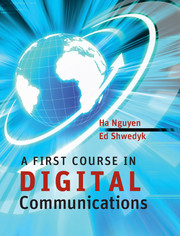Book contents
- Frontmatter
- Contents
- Preface
- Acknowledgements
- Abbreviations
- 1 Introduction
- 2 Deterministic signal characterization and analysis
- 3 Probability theory, random variables and random processes
- 4 Sampling and quantization
- 5 Optimum receiver for binary data transmission
- 6 Baseband data transmission
- 7 Basic digital passband modulation
- 8 M-ary signaling techniques
- 9 Signaling over bandlimited channels
- 10 Signaling over fading channels
- 11 Advanced modulation techniques
- 12 Synchronization
- Index
3 - Probability theory, random variables and random processes
Published online by Cambridge University Press: 05 June 2012
- Frontmatter
- Contents
- Preface
- Acknowledgements
- Abbreviations
- 1 Introduction
- 2 Deterministic signal characterization and analysis
- 3 Probability theory, random variables and random processes
- 4 Sampling and quantization
- 5 Optimum receiver for binary data transmission
- 6 Baseband data transmission
- 7 Basic digital passband modulation
- 8 M-ary signaling techniques
- 9 Signaling over bandlimited channels
- 10 Signaling over fading channels
- 11 Advanced modulation techniques
- 12 Synchronization
- Index
Summary
The main objective of a communication system is the transfer of information over a channel. By its nature, the message signal that is to be transmitted is best modeled by a random signal. This is due to the fact that any signal that conveys information must have some uncertainty in it, otherwise its transmission is of no interest. When a signal is transmitted through a communication channel, there are two types of imperfections that cause the received signal to be different from the transmitted signal. One type of imperfection is deterministic in nature, such as linear and nonlinear distortions, intersymbol interference (ISI), etc. The second type is nondeterministic, such as addition of noise, interference, multipath fading, etc. For a quantitative study of these nondeterministic phenomena, a random model is required.
This chapter is concerned with the methods used to describe and characterize a random signal, generally referred to as a random process and also commonly called a stochastic process. Since a random process is in essence a random variable evolving in time we first consider random variables.
Random variables
Sample space and probability
The fundamental concept in any probabilistic model is the concept of a random experiment. In general, an experiment is called random if its outcome, for some reason, cannot be predicted with certainty. Examples of simple random experiments are throwing a die, flipping a coin, and drawing a card from a deck.
- Type
- Chapter
- Information
- A First Course in Digital Communications , pp. 77 - 134Publisher: Cambridge University PressPrint publication year: 2009
- 1
- Cited by

